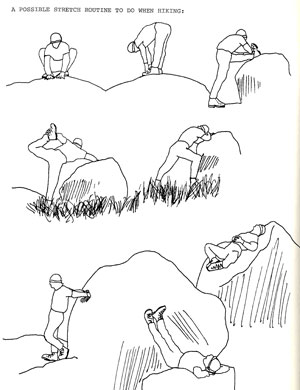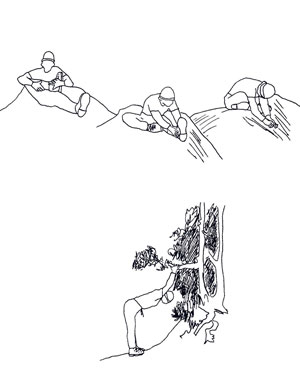 ™
™TRADITIONAL MOUNTAINEERING
™
www.TraditionalMountaineering.org
™ and also
www.AlpineMountaineering.org
™
 ™
™
FREE BASIC TO ADVANCED
ALPINE MOUNTAIN CLIMBING INSTRUCTION™
Home
| Information
| Photos
| Calendar
| News
| Seminars
| Experiences
| Questions
| Updates
| Books
| Conditions
| Links
| Search
![]()
Read more:
The TraditionalMountaineering Book Review of Stretching by Robert and Jean Anderson
I first learned about the importance of careful stretching when I was running forty miles a week in marathon race training and bagging peaks on weekends. Robert and Jean Anderson of Englewood Colorado published a landmark book on the subject in 1975.
Their first book "Stretching" was published on a typewriter or simple word processor and illustrated by Jean Anderson in simple clear line drawings. Jean decorated many of the figures with hand knitted caps which she sold by mail.
Bob Anderson was discovered by professional athletes and soon worked with players on national football and baseball teams. So called ballistic stretching to a national standard of flexibility had been the norm. Anderson's program is based on a two-phase slow, static stretching only up to the physical potential of each unique individual. Stretching is now a million copy best seller available on the web in paperback at a nominal cost.
Here is a quote from the original edition in 1975:
"When you begin a stretch, the first twenty to thirty seconds of the stretch is spent in the "easy stretch". Here you can totally relax while you feel an easy stretch. After this phase of stretching, slowly go into the "developmental stretch". Here the feeling of the stretch will become more intense but it should not be actual pain. Straining will keep you from relaxing, both mentally and physically. You should not stretch in the "drastic stretch". Here the body is uneasy and it is impossible to relax. Here the mind becomes dull. Here you may injure yourself.
When stretching, your breathing should be slow, rhythmical and under control. If you are bending forward to do a stretch, exhale as you bend forward and then breathe at a slow, rhythmical pace as you hold the stretch. Do not hold your breath while stretching. If the position of a stretch inhibits your natural breathing pattern, then obviously you are not in a relaxed position. Just ease up on the stretch to where natural, slow, rhythmical breathing is possible. If breathing is difficult, then you are straining, and straining is negative and leads to not doing.
There is absolutely no place for straining in stretching. Straining is very negative. Actually, it is absurd. So you must understand from the beginning that relaxation and a feeling of a "good stretch" is really the essence of stretching.
If you learn how to stretch without straining, every movement you make will become easier. It takes time to loosen up tight muscles or muscle groups, but time is quickly forgotten when you become regular with stretching. If you stretch to feel good and not to look different or to become flexible, you will surely find that how you feel is vastly more important than how you look. Stretching will help you more if you stretch for good feelings. Let your mind and body feel. If you learn to enjoy stretching and movement, then all the results of being regular with stretching will be yours.
As you become familiar with stretching, you will naturally find that your flexibility increases when you stretch in the developmental phase. As you learn to stretch and relax, the feelings of the stretch will change and you must gradually increase the stretch until the developmental phase is reached again. By gradually working within your own comfortable and painless limits, you will be able to go beyond your present limits and come closer to your personal potential."
"This diagram will give you an idea of a "good stretch":
<-----------------------------------------------------------------------------------A STRETCH--------------------------------------------------------------------------------->
<----AN EASY STRETCH------><-------THE DEVELOPMENTAL PART OF STRETCHING--------><--------A DRASTIC STRETCH----->
(HOLD FOR 20-30 SECONDS)-------------------(HOLD FOR 30 SECONDS OR LONGER)--------------------------------(DO NOT DO THIS!) "
Here is one of the sport specific routines for traditional mountaineering from the original edition:


Text and images Copyright© 1975 by Robert and Jean Anderson. All Rights Reserved.
This inexpensive paperback belongs in the
library of every Traditional Mountaineer.
--Bob Speik, www.TraditionalMountaineering.org
Former Chair of the Mountaineering Training Committee, Sierra Club's Angeles
Chapter
Read more . . .
![]() Search this site!
Search this site!
books
bibliography
Freedom of the Hills, 7th edition